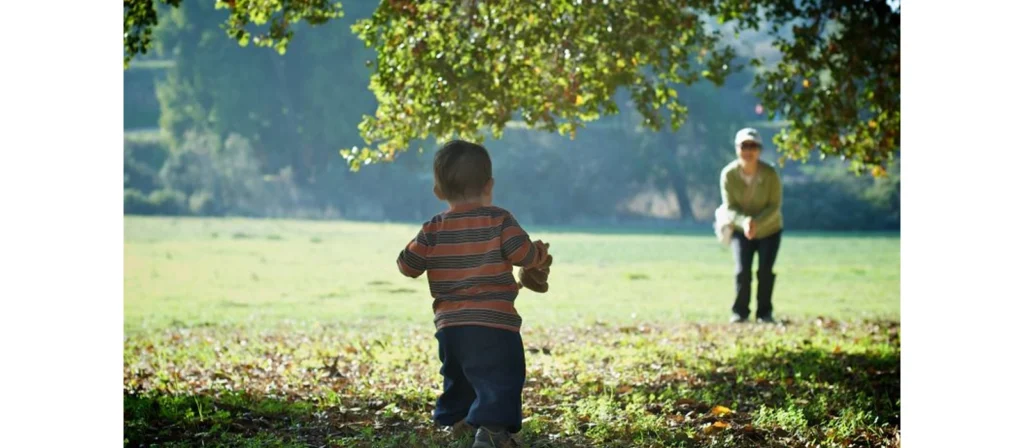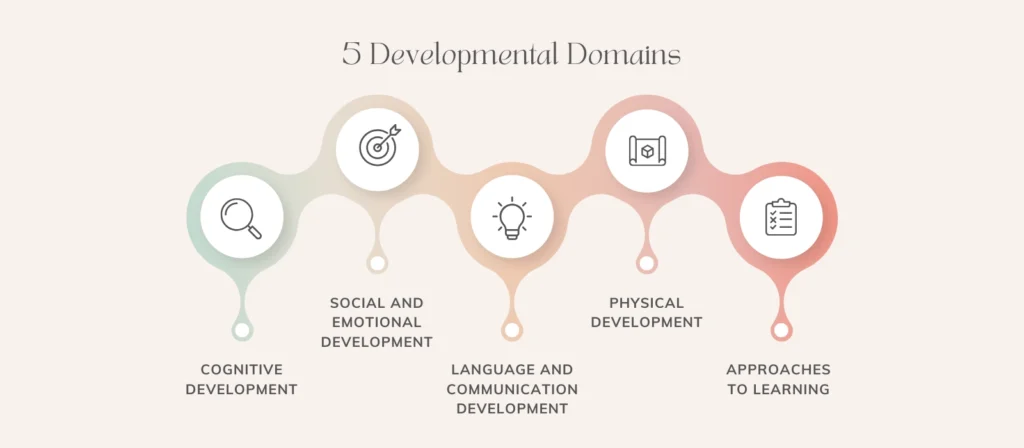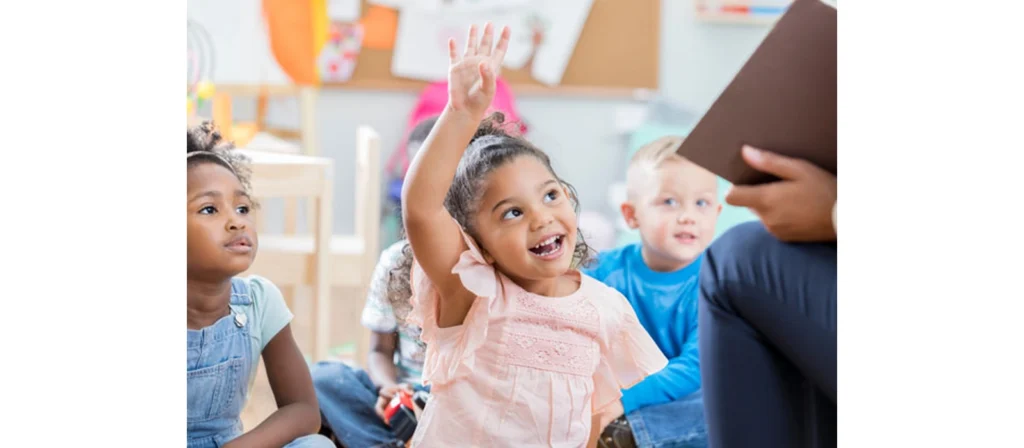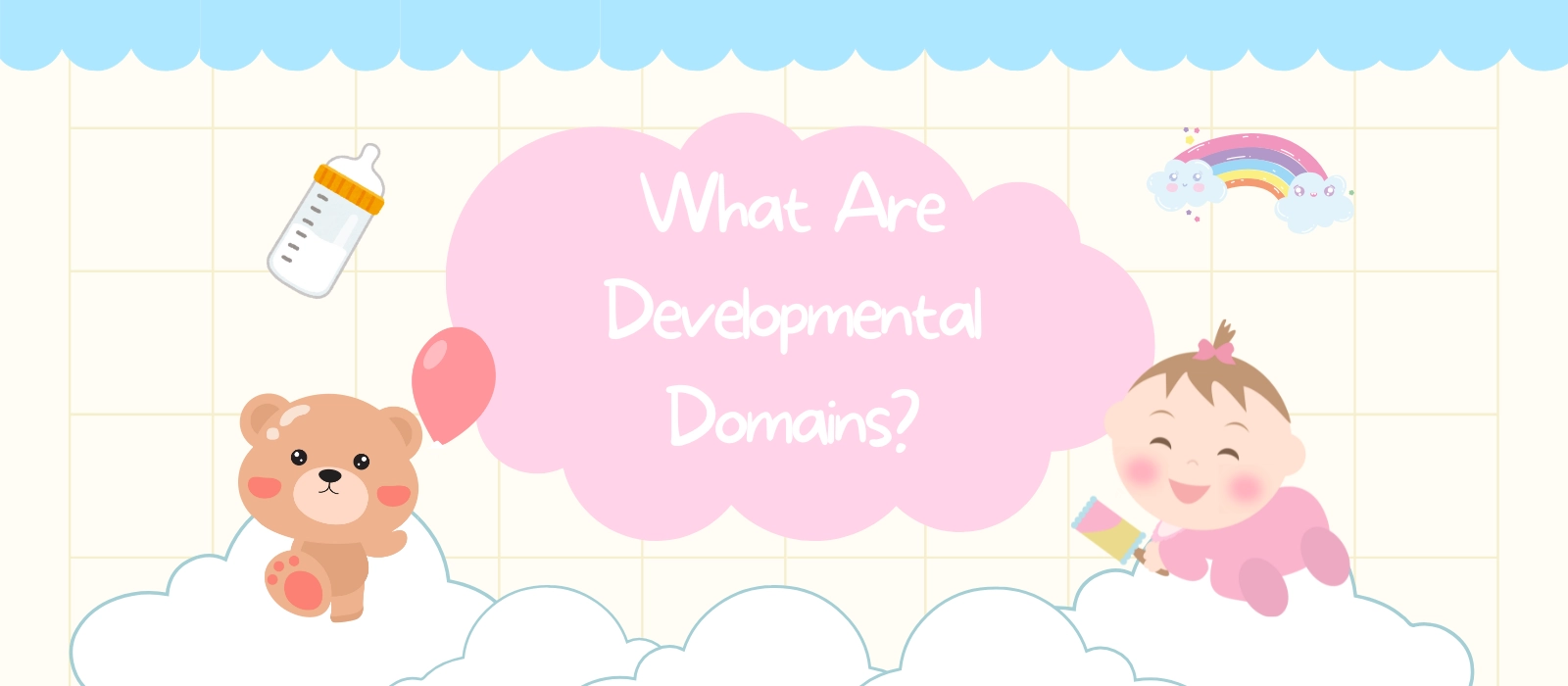Are you struggling to create a kindergarten environment that supports whole-child development? Wondering how to make sure your space helps children grow intellectually, socially, emotionally, and physically? Feeling lost when choosing furniture that aligns with early learning needs?
Developmental domains are the five key areas of growth every child experiences in early childhood: cognitive, social-emotional, language, physical, and approaches to learning. Understanding and supporting these domains ensures children thrive not only in academics but in life.
In this article, I’ll explain each domain clearly and show how to use furniture and learning environments to support them effectively. Whether you’re opening a new preschool or optimizing your current space, this guide will help you align your setup with children’s developmental needs.
What Is a Developmental Domain?
A developmental domain refers to a specific area of a child’s overall growth and learning. These domains represent the fundamental aspects of early childhood development that educators and caregivers should nurture and observe. Each domain functions independently to some extent, but they are deeply interconnected and influence each other throughout a child’s formative years.

The concept of developmental domains is used widely in early childhood education as a framework for creating appropriate learning environments and monitoring children’s progress. These domains help educators plan curriculum, activities, classroom design, and even furniture selection that meets developmental milestones.
Developmental domains are not just abstract ideas—they are measurable, observable aspects of a child’s development. For example, while a child is learning to express feelings (social-emotional development), they are also developing language skills (communication development). Likewise, when children climb, jump, or balance, they are working on physical development, while problem-solving games target cognitive growth.
Why Developmental Domains Matter in Early Childhood?
In early childhood, every experience a child has—whether playing with blocks, listening to a story, or sharing a toy—contributes to their development in multiple domains. These interactions are not isolated. They are deeply intertwined, and their impact can shape a child’s learning capacity, emotional intelligence, and social skills for years to come.
Understanding developmental domains enables educators and parents to provide a holistic education. When teachers are aware of the five core domains, they can observe more accurately, identify strengths and challenges early, and design learning environments that cater to each child’s developmental needs.
For example, a preschool that focuses only on academic skills like counting and reading might neglect physical or emotional development, leading to delays in motor skills or difficulties in peer interactions. In contrast, a classroom that incorporates active play, emotional coaching, storytelling, and open-ended exploration supports well-rounded growth.
Research consistently shows that high-quality early learning environments that address all developmental domains lead to better outcomes in primary school and beyond. According to Harvard University’s Center on the Developing Child, “early experiences affect the development of brain architecture, which provides the foundation for all future learning, behavior, and health.”
In a global context, this understanding also influences educational policy, curriculum design, teacher training, and even how schools are evaluated for quality. For kindergarten directors and school founders like our customers, recognizing the significance of developmental domains helps prioritize space design, teacher recruitment, and procurement with a purpose.
Ultimately, acknowledging the importance of developmental domains empowers decision-makers to move beyond aesthetics or price alone and build environments where children can truly thrive.
How Many Domains Do Developmental Milestones Cover?
Developmental milestones are typically grouped into five essential domains. Each one addresses a critical dimension of early childhood growth. Below is a breakdown of each domain and its focus:

Cognitive Development
Cognitive development includes the mental skills children use to think, learn, remember, and solve problems. From identifying shapes to understanding cause-and-effect, this domain lays the groundwork for academic achievement and lifelong learning.
Social and Emotional Development
This domain focuses on how children understand themselves and relate to others. It includes emotional regulation, empathy, cooperation, and the ability to form healthy relationships—all foundational for classroom success and personal well-being.
Language and Communication Development
Language development is more than just talking. It involves listening, understanding, asking questions, storytelling, and eventually reading and writing. A strong foundation in communication supports every other developmental domain.
Physical Development
This domain involves both gross motor skills (like running and jumping) and fine motor skills (like using utensils or drawing). It’s also about bodily health, coordination, and spatial awareness—all crucial for independence and exploration.
Approaches to Learning
This often-overlooked domain includes curiosity, persistence, initiative, and creativity. It reflects how children approach learning challenges, engage with materials, and sustain attention—skills that deeply influence future academic performance.
Together, these five domains offer a comprehensive view of a child’s early development. By addressing each one, educators can ensure a balanced approach that nurtures the whole child.
Cognitive Ability and Knowledge Retention is a Developmental Domain
Cognitive development refers to how children think, explore, and figure things out. This domain includes memory, reasoning, problem-solving, and decision-making. It forms the mental foundation for learning in school and beyond.

Key Components of Cognitive Development
- Information processing
- Cause and effect understanding
- Symbolic thinking (imagination and pretend play)
- Problem-solving and logic
Cognitive Development by Age Group
Infants (0–12 months)
- Explore the world through senses (looking, touching, mouthing).
- Recognize familiar people and objects.
- Begin to anticipate outcomes (e.g., peekaboo games).
Toddlers (1–3 years)
- Develop object permanence and basic problem-solving.
- Begin sorting objects by shape and color.
- Show interest in how things work (e.g., opening drawers, stacking blocks).
Preschoolers (3–5 years)
- Ask many “why” questions.
- Use logic to solve simple problems.
- Understand sequencing and basic math concepts (counting, comparing).
Supporting Cognitive Development Through Environment
At XIHA Furniture, we help foster curiosity and exploration through:
- Open shelving that promotes self-selection of learning tools.
- Activity tables for puzzles, logic games, and STEM materials.
- Visual displays and inquiry stations to encourage questioning and observation.
Social and Emotional Development is a Developmental Domain
This domain includes how children manage emotions, build relationships, and develop a sense of self. Emotional intelligence and social skills affect behavior, learning ability, and mental well-being.

Key Components of Social-Emotional Development
- Self-awareness
- Emotion regulation
- Empathy and cooperation
- Peer interaction and social problem-solving
Social-Emotional Development by Age Group
Infants (0–12 months)
- Form attachments with caregivers.
- Express joy, distress, and curiosity.
- Respond to facial expressions and tone of voice.
Toddlers (1–3 years)
- Experience big emotions and need help managing them.
- Begin parallel play and early social engagement.
- Show emerging independence.
Preschoolers (3–5 years)
- Engage in cooperative play.
- Understand turn-taking and sharing.
- Express empathy, follow basic rules, and manage frustration.
Supporting Social-Emotional Growth
At XIHA, our classroom furniture encourages emotional security and positive interaction through:
- Cozy reading and quiet zones.
- Group tables and dramatic play areas for cooperative play.
- Emotion boards, puppet corners, and soft seating to support expression.
Language and Communication Development is a Developmental Domain
Language and communication skills form the basis for literacy and social exchange. This domain includes speaking, listening, comprehension, and early reading and writing.

Key Components of Language Development
- Receptive language (understanding)
- Expressive language (speaking)
- Phonological awareness
- Vocabulary and grammar acquisition
Language Development by Age Group
Infants (0–12 months)
- Respond to sounds and voices.
- Use cooing, babbling, and gestures (like pointing).
- Recognize their name.
Toddlers (1–3 years)
- Use short phrases and basic vocabulary.
- Understand and follow simple instructions.
- Name common objects and people.
Preschoolers (3–5 years)
- Speak in full sentences.
- Ask and answer questions.
- Retell short stories and begin understanding print concepts.
Supporting Language Development in the Classroom
XIHA offers tools to enhance language-rich settings:
- Accessible book displays and storytelling chairs.
- Interactive language centers with puppets and role-play tools.
- Table arrangements that foster conversation.
Physical Development is a Developmental Domain
Child development is categorized into five interconnected developmental domains. One of the most observable and foundational is the Physical Development Domain—the area concerning bodily growth, motor skills, and coordination. Here’s a more in-depth look at how physical development unfolds by age and how it intersects with broader developmental progress.

Key Aspects of Physical Development
Physical development is typically divided into two subdomains:
Gross Motor Development: Involves large muscle groups used for activities like crawling, walking, running, and climbing. These movements are vital for spatial awareness, independence, and confidence.
Fine Motor Development: Uses smaller muscle groups, particularly those in the hands and fingers, for precise tasks like grasping, cutting, drawing, and buttoning. These skills are essential for writing, self-feeding, and manipulating small objects.
| Aspect | Gross Motor Development | Fine Motor Development |
|---|---|---|
| Skills Involved | Walking, running, climbing, balancing | Drawing, cutting, buttoning, grasping objects |
| Muscle Groups | Large muscles of arms, legs, torso | Small muscles of hands and fingers |
| Developmental Impact | Builds strength, balance, and coordination | Improves dexterity, focus, and independence |
| Examples | Jumping, riding tricycles, sports play | Stacking blocks, using utensils, writing |
Physical Development by Age Group
Infants (0–12 months)
- Develop head control, roll over, sit up with support, crawl, and stand.
- Begin reaching and grasping toys, transferring objects between hands.
- These motor skills support their exploration and help build sensory understanding of the world.
Toddlers (1–3 years)
- Master walking and running, begin climbing and navigating stairs.
- Engage in play involving movement: dancing, kicking balls, or riding push toys.
- Refine fine motor tasks like building block towers, feeding themselves, and turning book pages.
Preschoolers (3–5 years)
- Hop, skip, jump with control, ride a tricycle, walk backward.
- Improve hand control for coloring inside lines, cutting with scissors, and dressing themselves.
- These improvements increase independence and prepare them for school routines.
Why It Matters
Physical development is not isolated from other domains—it directly supports cognitive and social-emotional growth. Children who can move confidently are more likely to explore, engage in peer play, and take learning risks. It fosters resilience, creativity, and problem-solving.
Supporting Physical Growth Through Environment
At XIHA Furniture, we design furniture that meets children at every stage of physical development:
- Soft play zones and mats for infants to crawl safely.
- Adjustable tables and child-sized seating to encourage fine motor refinement.
- Gross motor stations like balance boards, climbing blocks, and push carts.
Approaches to Learning is a Developmental Domain
This domain captures how children engage in learning—curiosity, initiative, persistence, and creativity. It’s not about what they learn, but how they learn.

Key Components of Approaches to Learning
- Task engagement and attention span
- Motivation to learn
- Initiative and risk-taking
- Persistence with challenges
Approaches to Learning by Age Group
Infants (0–12 months)
- Observe surroundings with curiosity.
- Repeat actions that produce interesting outcomes.
- Focus on people and objects for longer periods.
Toddlers (1–3 years)
- Explore independently.
- Show determination (e.g., stacking until it works).
- Try new ways of doing familiar things.
Preschoolers (3–5 years)
- Plan and complete tasks.
- Shift focus when needed.
- Experiment with creative materials and activities.
How XIHA Encourages Learning Behaviors
Our flexible furniture empowers children to:
- Choose their own materials from open shelves.
- Arrange furniture for different types of projects.
- Stay focused with personalized workspaces and materials.
What Every Kindergarten Director Should Know About Developmental Domains
As a kindergarten director, understanding the five developmental domains isn’t just a theoretical exercise—it’s essential to designing and running a high-quality early education program. Every decision you make, from how classrooms are laid out to what furniture is selected, can directly affect how well each domain is supported.
Children thrive in environments where all five developmental domains are intentionally nurtured. When you think about your school’s daily routines, learning stations, and materials, ask yourself: are they encouraging emotional growth, stimulating cognitive thinking, promoting physical activity, enabling expressive language, and inspiring curiosity?
Awareness of these domains allows you to:
- Evaluate if your current classroom settings are developmentally balanced
- Train your teachers to observe and nurture different domains equally
- Communicate better with parents and stakeholders about your education philosophy
- Make smarter purchasing decisions that reflect your school’s mission
In fact, many of the school owners we serve—especially those expanding into North America and Europe—use developmental domains as their framework for procurement planning. It helps them avoid common mistakes, such as over-investing in literacy corners while neglecting physical play or social development zones.
By adopting this approach, you align your vision with best practices in early childhood education. You also increase the overall educational value of your learning space, creating an environment that truly supports whole-child development and prepares students for long-term success.
Checklist: Does Your Classroom Support All Five Domains?
Creating a learning environment that supports all five developmental domains doesn’t happen by accident—it requires thoughtful planning, intentional design, and regular evaluation. Below is a practical checklist designed for kindergarten directors, preschool owners, and early learning educators to self-assess whether their classrooms are developmentally balanced.
🧠 Cognitive Development
- Are there puzzles, sorting games, and open-ended problem-solving materials available?
- Is there a designated area for experimentation and inquiry-based learning?
- Do teachers ask open-ended questions that promote thinking and reasoning?
🧍♀️ Physical Development
- Is there a space for active gross motor movement (climbing, running, balancing)?
- Are fine motor tools available (tweezers, blocks, scissors, crayons)?
- Is the classroom furniture height-appropriate and easy to move?
🗣️ Language and Communication
- Are there books accessible at the child’s level in various languages?
- Are listening centers or storytelling props provided?
- Do classrooms encourage peer-to-peer and teacher-student dialogue?
🤝 Social-Emotional Development
- Are there “quiet corners” for emotional regulation or alone time?
- Is there a system for resolving conflict (emotion charts, puppets, etc.)?
- Are group activities designed to promote collaboration and empathy?
🎨 Approaches to Learning
- Are children encouraged to initiate their own projects?
- Do teachers recognize and support persistence and effort?
- Are creative and imaginative play materials integrated into daily use?
A developmentally complete classroom doesn’t require massive investment—it requires a mindset. Even small changes in furniture layout, daily routines, or teaching interactions can dramatically impact how well children thrive across all five domains.
How to Train Your Teachers to Use the Environment for Development
The classroom environment is only as effective as the educators who bring it to life. Teachers play a central role in making developmental domains visible and functional through daily interactions, intentional planning, and use of space. Training your teaching staff to observe, respond to, and extend learning across all five developmental domains is critical to a successful early education program.

Why Teacher Training Matters
Without training, even a well-designed classroom may fall flat. Educators need to understand not just the ‘what’ of each domain but the ‘how’—how to observe, how to scaffold development, and how to integrate developmental thinking into every part of the day. A well-trained teacher knows that handing a child a puzzle supports cognitive growth, but prompting them with, “What do you think happens if you turn it?” supports curiosity and persistence too.
Core Areas to Focus On
- Environment as a Tool: Teach educators how to use physical spaces intentionally—for example, using cozy reading nooks to support language and emotional development.
- Observation Skills: Help teachers identify behavioral cues linked to developmental progress (e.g., delayed fine motor skills or emerging self-regulation).
- Developmentally Appropriate Practice (DAP): Offer guidelines on what is age-appropriate and culturally relevant.
- Integrated Activities: Demonstrate how a single activity can support multiple domains (e.g., dramatic play involves social, emotional, language, and cognitive skills).
Sample Training Modules
- “Designing Spaces That Teach” – A walkthrough of how environment impacts learning.
- “Domains in Action” – Hands-on training with materials mapped to each domain.
- “Daily Routines with Purpose” – Infuse domain-awareness into transitions, mealtimes, and play.
How XIHA Can Help
At XIHA Furniture, we don’t just supply furniture—we support entire learning ecosystems. For clients looking to integrate developmental domains into staff development, we offer training partnerships, demo room layouts, and one-on-one planning support to align your staff’s skillset with your learning environment.
Training your team is an investment with long-term returns: improved child outcomes, better teacher retention, and a stronger reputation for your center. Empowered teachers create empowered learners—and that starts with domain-based professional development.
Conclusion
Understanding developmental domains is essential for nurturing children’s growth in a balanced, intentional way. From cognitive development to physical coordination, from emotional regulation to language mastery, each domain plays a vital role in shaping a child’s lifelong learning journey. At XIHA Furniture, we believe the learning environment should actively support every developmental domain—not just passively house children. That’s why our furniture solutions are tailored to promote engagement, independence, creativity, and developmental success across all five domains. Whether you’re setting up a new preschool or improving an existing one, aligning your choices with developmental domains is the smartest investment in children’s futures.



